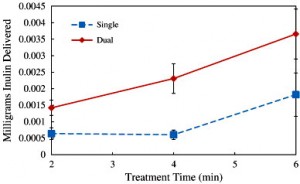A breakthrough by MIT Engineers is making waves in medical drug administration- literally. Previous studies explored using low ultrasound frequency waves rather than a shot or pill to deliver drugs. How is that possible? The ultrasound waves make the skin more permeable allowing drugs to be administered directly on to and passively through the skin. Results of these studies, however, have been lacking. What researchers have now discovered is the key to success is a combination of both a low and high frequency wave.
Why bother with area of research when we already have pills or shots to give us vaccines or drugs? The possible use of this technique has huge implications on how medicine is produced and administered in the future. Not only is this drug delivery painless, but also direct and noninvasive to the skin.
Watch the video below where Carl Schoellhammer, one of the lead researchers, explains how this technique works:

Youtube video from user MITNewsOffice
To summarize: a high and low frequency create tiny bubbles in a solution, which implode causing jets of water to remove the very top layer of skin. Drugs are able to be applied via patch or as the fluid the bubbles are created in.
What does this mean for the future?
On a broader scope, if the ultrasound device is made easily available and affordable for wide spread use in hospitals, the need for needles could be hugely reduced. Needle free drug delivery could potentially be more sterile and safer. It could reduce the degree of negative effects or injury from contaminated or damaged needles as well as the dangerous waste of used needles. This change in medical procedure could specifically have a huge effect on third world countries concerning sterility and treatment problems.

Insulin uptake after single freq (blue) and dual freq (red) treatments. Adapted from: Schoellhammer, C. M., et al, 2012
On a smaller scale, practical use of this treatment in the future could changethedaily life and health of diabetics. The two compounds a study used were glucose and insulin, and the results showed that they were successfully delivered passively through the skin.
Eventually, this ultrasound technique could just become an alternative for those who are uncomfortable with swallowing pills or can’t tolerate needles. I, for one, have a vested interest to see where this treatment goes in the future. Because, really, who doesn’t dread getting a shot from the doctors?
– Rachel Chang
References:
Canadian Center for Occupational Health and Safety : http://www.ccohs.ca/oshanswers/diseases/needlestick_injuries.html
Johnson, M.E. et al. “Synergistic effects of chemical enhancers and therapeutic ultrasound on transdermal drug delivery.” J Phram Sci. 12 June. 2012. Web. http://www.ncbi.nlm.nih.gov/pubmed/8818988 (accessed Oct, 1, 2012)
MIT Media Relations. “Getting (drugs) under your skin.” http://web.mit.edu/press/2012/ultrasound-waves-and-drug-delivery.html (accessed Oct, 1, 2012)
Ogura, M. et al. “Low-frequency sonophoresis: Current status and future prospects.” Adv. Drug Deliv. Rev. 3 Aug. 2008. Web. http://www.sciencedirect.com/science/article/pii/S0169409X08000860 (accessed Oct, 1, 2012)
Polat, B.E. et al.”Transport pathways and enhancement mechanisms within localized and non-localized transport regions in skin treated with low-frequency sonophoresis and sodium lauryl sulfate.” J Pharm Sci.10 Aug. 2011. Web. http://www.ncbi.nlm.nih.gov/pubmed/20740667 (accessed Oct,1, 2012)
Schoellhammer, C. M. et al. “Rapid Skin Permeabilization by the Simultaneous Application of Dual-frequency, High-intensity Ultrasound.” J. Control. Release. 22 Aug. 2012. Web. http://dx.doi.org/10.1016/j.jconrel.2012.08.019 (accessed Oct,1 , 2012)
Image source: http://www.europarl.europa.eu/resources/library/images/20081030PHT41044/20081030PHT41044_original.jpg
Schoellhammer, C. M. et al. “Rapid Skin Permeabilization by the Simultaneous Application of Dual-frequency, High-intensity Ultrasound.” J. Control. Release. 22 Aug. 2012. Web. http://dx.doi.org/10.1016/j.jconrel.2012.08.019


